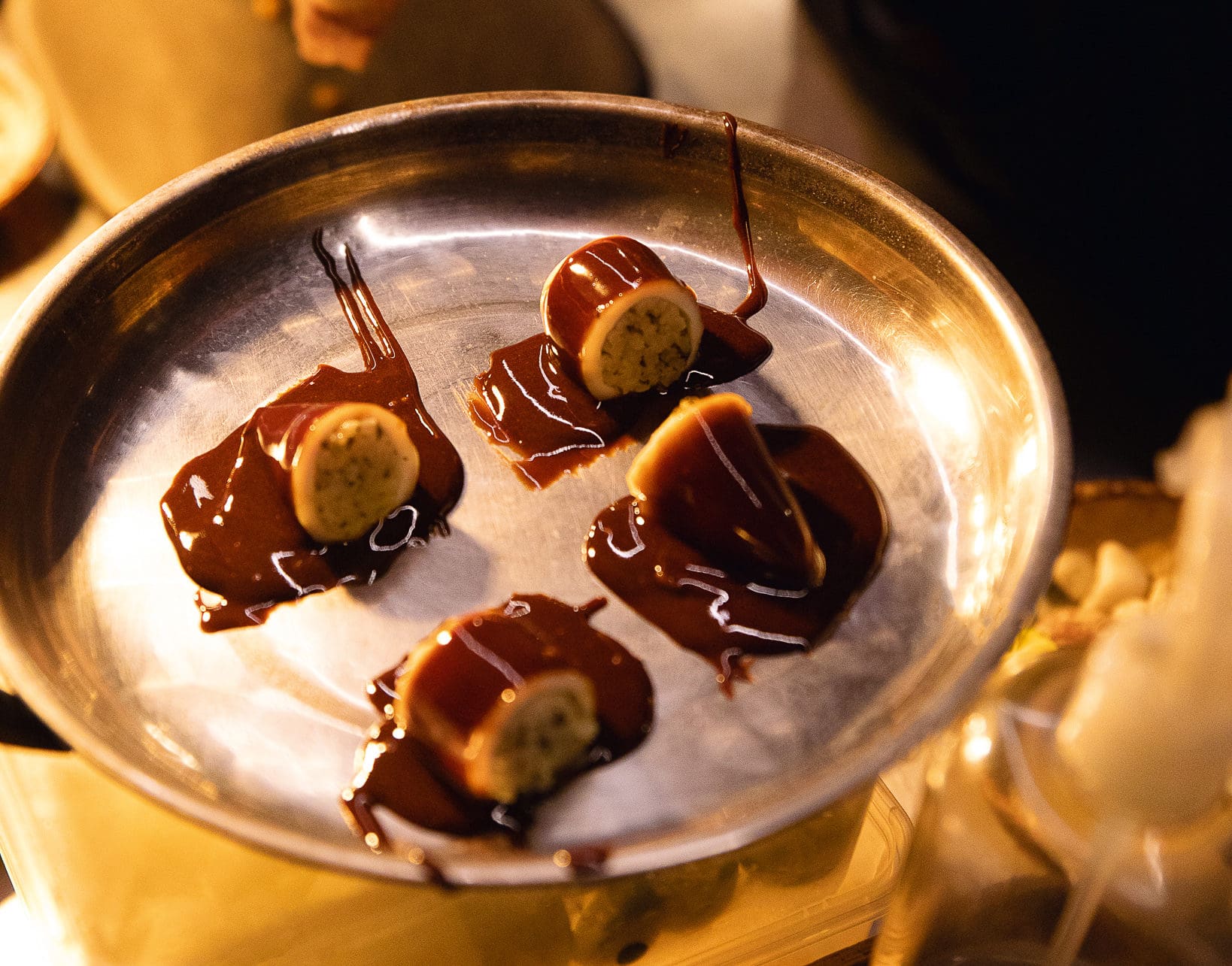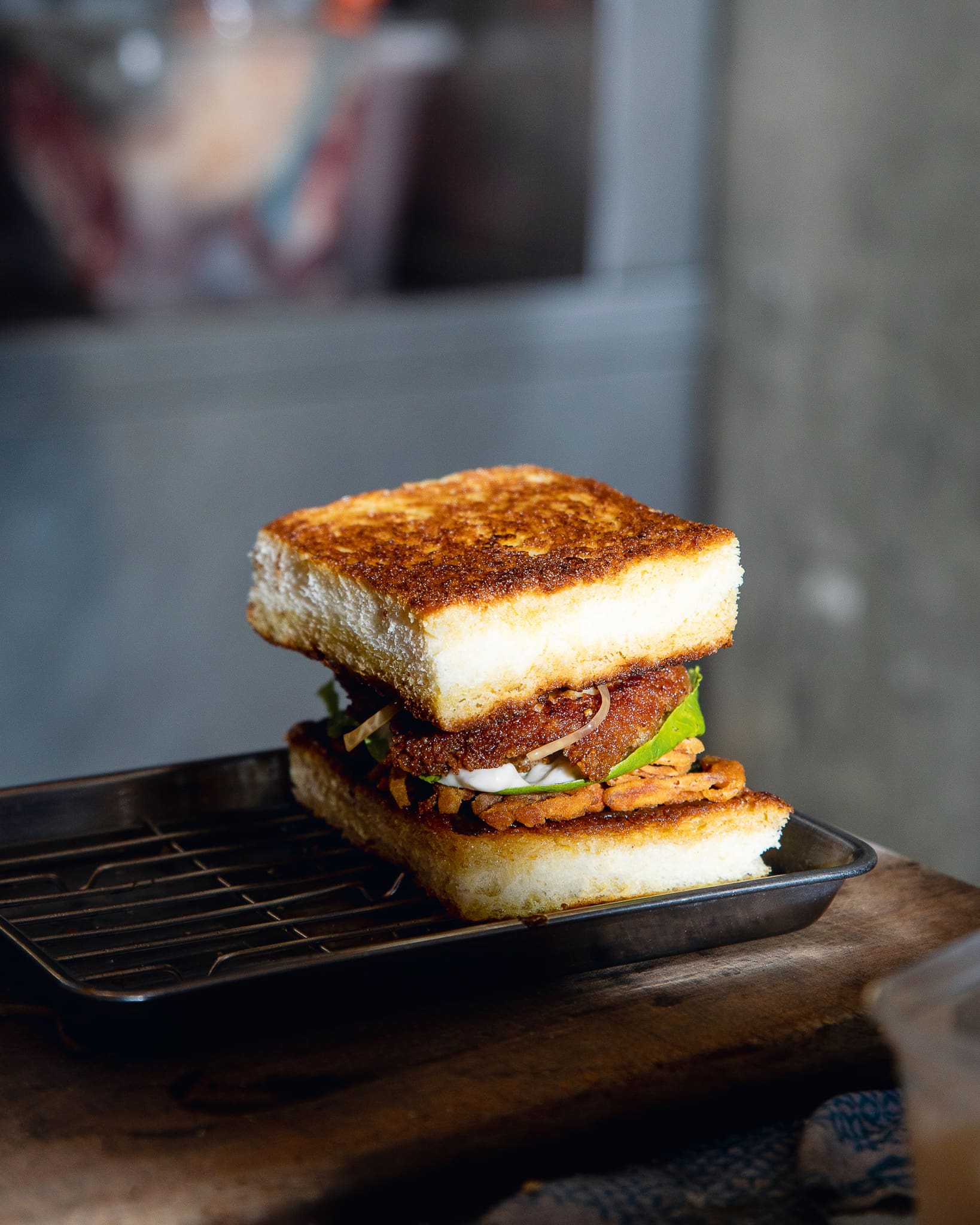Chef Edmund Marce
Geric Cruz
Popular media has made a spectacle out of kitchen life, crystallizing the bad boy chef (Anthony Bourdain) and the sad boy chef (Carmy Berzatto of The Bear) as part of this century’s culinary zeitgeist. Gastronomic excellence is often attributed to making a habit out of perfection. Yet attaining this has become synonymous with machismo, with toxic workplaces, and the rigid hierarchy of a brigade de cuisine.

“The typical kind of kitchen life is very different from Toyo,” Likha Camacho tells Vogue Philippines.
Decorated in intricate tattoos and a shaved down buzzcut, he’s part of a dedicated research and archiving division under Toyo Eatery which informs the restaurant’s approach to Filipino food. To no surprise, the Filipino restaurant has been ranked among Asia’s 50 Best Restaurants in both 2019 and 2021.
That’s why the Toyo story is peculiar in the restaurant scene. Likha continues, “It’s not sex, drugs, and rock ‘n’ roll here. We’re more like athletes. We take care of ourselves, and we treat every day and every service like a championship game.”
At 10:30 A.M. on an idle Tuesday morning, there is a slow buildup of people dressed in black T-shirts and slacks making their way to the doors of Toyo at the pathway of Karrivin Plaza’s The Alley. Some of them ride into the alley with their bikes, and an unusual number of them are sporting Birkenstock Bostons—classic commis attire.
Queen’s “Don’t Stop Me Now” blasts from inside Toyo Eatery, while Panaderya Toyo simultaenously plays Sandwich’s “Betamax.” Inside Toyo, Freddie Mercury belts “I’m having such a good time!” as junior sous chef Edmund Marce and other chef de parties scrub down the kitchen. (Kitchen music, as the staff of Toyo have revealed, gives a sense of comfort amidst the 12-hour routine.) Eventually the chefs head to their respective stations. With precision, they unroll their knife bags, lay out chopping boards, bring in wads of kangkong, carts of calamansi, and gut a fresh mackerel the size of my arm.
From dusk to dawn, the chefs race to ready the long list of ingredients in time for dinner service at 6 P.M. Bettina Tañedo, who’s assigned to pastry, checks on the leche flan ice cream she’s been working on. She then blends it into a puree, after which the mixture is aged for a day to meld the flavors. “We don’t choose the shortcuts over the long process because there’s a lot of traditional cooking methods we want to honor,” she says.


The reality of kitchen life indisputably demands dedication and discipline, but it seems like everyone at Toyo is driven by the same kind of crazy. “It’s long hours, you’re standing all day, it’s hot, and you’re dealing with a lot of people,” says Pau Achacoso, who’s a part of Toyo’s front-of-house staff.
Toyo, the condiment, can be found in every Filipino household and is used in everyday Filipino cuisine, but its ubiquity belies its complexity. “There’s so much care involved in making soy sauce, even when it comes to processing its raw ingredients,” Pau explains. The long fermentation process echoes how Toyo takes a mindful and slow-food approach to everything that they do.
Toyo’s name is a double entendre on the eatery’s philosophy on food and the kind of crazy it takes to endure a kitchen life of passion and integrity. Much of it comes from the idiom “May toyo ang utak” which has become a strong identifier among the entire staff. “Everyone here is a bit crazy. Being with them for 12 to 16 hours a day, it’s basically your home,” Likha says.
Head chef Jordy Navarra and sous chef JP Cruz make it a point to inform the entire team of the context behind every ingredient, raw material, and the traditional Filipino cooking methods they all work with. They’ve feasted with and spoke to farmers in Zambales and Tarlac; partnered with the weaving communities of Luisiana, Laguna for the panaderya’s known taklob packaging; and found unique produce like the native tublay lemon of Benguet.
Part of the 12 dishes served in its tasting menu is Toyo’s own interpretation of siomai rice. The inspiration? Chef JP shares that many of their items are based on the specificities of the Filipino experience: “Everyone has a story with siomai rice. For us, it was Hen Lin or those eateries found outside your college. There used to be a Hen Lin outside of Karrivin Plaza,” Chef Edmund interjects, “We always had lunch there. That’s why it’s very familiar.”

Toyo’s creativity teeters between an earnest reverence to tradition and an insatiable drive to push boundaries. “I remember we tried to make patis out of squid, and it was really bad!” adds Toyo’s communications head, Miguel Ortega. Perhaps, then, the genius of each dish is borne out of Toyo’s ethos of believing everyone in their team is a chef: “In a way we’re like a collective. We harness everyone’s identity here. We won’t try to box you,” Likha says.
“We have a routine here. Sometimes it feels like you’ve become a machine more than a thinking thing,” Bettina says, “but our day-to-day practice is informed. With our trips to the farms, you become more informed about all the struggles of growing [produce]. When it gets to your chopping board, it puts meaning into what you do and you just want to protect this product that they’ve given you, to not waste it—even in the way you chop it, your knife skills must be on point because there’s integrity in these things. It’s connected to the whole reason why we do this and being proud of our land.”
As dinner service approaches, the entire Toyo staff gathers in the dining area for the staff meeting. Chefs, bakers, front-of-house, and management alike sit on top stairs, corridors, or dining seats, while they eat the staff meal—usually a hearty lunch of Toyo’s oversupplied ingredients.
At the kabisera seat is sous chef JP Cruz, who runs through tonight’s game plan—from dishes to be served, private events, down to allergies of incoming guests. JP has been neck-deep in Toyo since day zero, having worked with Jordy during their days at Black Sheep (a known degustation restaurant in BGC during the 2010s).
As a fresh culinary school graduate, JP went to work a series of kitchen jobs in and around Metro Manila. “There came a point where I stopped F&B. I worked in various restaurants but there was no heart. I felt burnt out,” he recalls. One day, Cruz got a call from an old culinary school classmate, Jordy Navarra, who shared his plans on a restaurant focused on exploring, re-discovering, and giving a platform to the diversities of Filipino cuisine. Eventually, Cruz and Navarra left Black Sheep to start Toyo, and the rest is history.

“It’s not sex, drugs, and rock ‘n’ roll here. We’re more like athletes. We take care of ourselves and we treat every day and every service like a championship game”
The doors of Toyo open. Chefs fire their stations, front-of-house staff exchange their aprons for walkie-talkies, and guests are guided to their seats. Chef Liaa Roy, who’s handling Pass for tonight, arranges and marks down order tickets with color-coded sharpies in hand: “Table 4, 2 orders of Tortang Talong; table 5, 2 for the tasting menu.” The kitchen confirms, and they hail, “yes, chef!”
Come closing time, David Bowie’s “Heroes” plays from the kitchen as the staff scrubs down stainless steel counters and silverware. The place cools to light chatter as chef Edmund lovingly makes another staff meal for a tired brigade of cooks and floor staff.
Pastry chef Bettina shares that she ends her shift at 1 or 2 in the morning. “I do it all over again the next day—but I really wouldn’t choose any other place to work at.”
This article originally appeared in Vogue Philippines October 2022′ issue.
